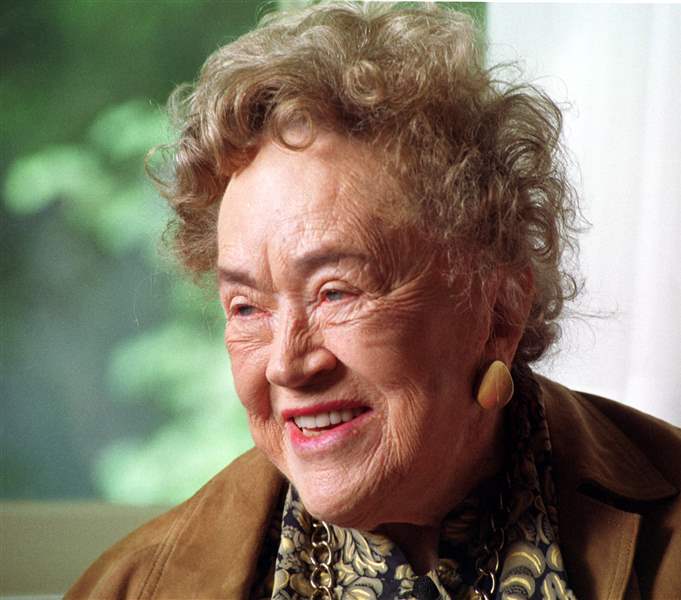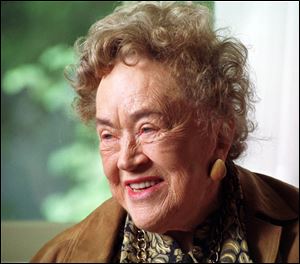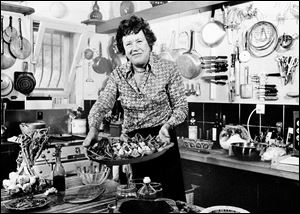
Julia Child taught us to love food, and women to take pride in making it
5/15/2012
Julia Child in 2001.
ASSOCIATED PRESS

Julia Child in 2001.
Massaging poultry, dropping food and utensils, and warbling her way through boeuf bourguignon and coq au vin, Julia Child left an indelible mark on American food.
As television's towering, ebullient "French Chef," Child put within reach of the average American a cuisine most had only heard about. Using fresh ingredients and copious amounts of wine, she changed the way we thought about food, demystifying it and placing it firmly at the center of a joyous life.
But as we approach her 100th birthday, coming Aug. 15, what's less obvious is how Child also revolutionized the way women saw cooking -- and themselves.
"Julia turned women on to the beauty of making a wonderful meal for the family, not just scraping something together," says Bob Spitz, author of the forthcoming Child biography Dearie (Knopf, August, 2012).
"She let women who watched her feel that they would be heard, that they could do anything she could do," he said. "She wanted women to be proud of what they did. That was so important to her. That pride. She had found it. And she wanted others to find it too."
Child didn't come from pride. Wealth, yes, but pride took longer.
Raised in Pasadena, Calif., the eldest child of a prosperous land manager and a paper-company heiress, Child went to Smith College where she partied more than studied and aspired to get married. After college and a series of uninspiring jobs, she joined the Office of Strategic Services, the precursor to the Central Intelligence Agency, and was sent to Ceylon, now Sri Lanka. It wasn't until she married Paul Child, an artist and diplomat, and moved to Paris that she found herself.
In France, she studied at Le Cordon Bleu culinary school, then began work on Mastering the Art of French Cooking with two French colleagues. It was a game-changing cookbook that, unlike its predecessors, outlined every step of a recipe.
That was a bold change for the American palate in 1961, an era in thrall to the convenience food industry.

Chef Julia Child shows a salade nicoise she prepared in the kitchen of her vacation home in Grasse, southern France.
It was a time when a constant drumbeat of advertising and what passed for food journalism told women they had no time to cook, says Laura Shapiro, a culinary historian and author of Julia Child: A Life. Women were being told they needed canned fruit, frozen vegetables, cake mixes, and TV dinners. The fresh food available in supermarkets was segregated, wrapped in plastic, and untouchable. The cookbooks of the period reflected this.
"The whole trend was to make it fast and easy, and what they considered easy was almost a quick summary of what you did -- boil the beef for an hour and a half in a cup of wine and water and that's boeuf bourguignon," says Judith Jones, the book editor who rescued Mastering the Art after it suffered multiple rejections from a publisher who wanted it revised to include packaged goods and fewer steps. "Julia made the distinction between the home cook just cooking, putting it on the table, and cooking with finesse, tasting and understanding what she was doing. She believed that that's where the joy came."
It was a time of social -- and particularly gender -- upheaval in America: The birth control pill was introduced, sexual mores were changing, women were working. Americans were making money, buying houses, supporting the growth of lifestyle magazines, including Gourmet.
And anything French was in fashion. The Kennedys -- and their French chef -- were in the White House. Jackie wore Chanel and Dior. She spoke fluent French. French food such as coquilles St. Jacques and quiche already had made it into middle class homes, Ms. Shapiro says, and there were even some French cookbooks around. Soldiers had returned from Europe more worldly and the advent of inexpensive airline travel meant more Americans were seeing foreign lands.
Then Mastering arrived on the scene.
"People were waiting for that book," Ms. Shapiro says.
Yet it got off to a slow start, Ms. Jones says. It was helped by a swooning review from New York Times food editor Craig Claiborne, but it was when Child got on television that her appeal and message finally saturated the culture.
The French Chef began airing in 1963, the same year that Betty Friedan's feminist tract The Feminine Mystique was released, and the underlying messages were strangely similar.
"It was to take your life in your own hands," Ms. Shapiro says. "You have a home and a family, if you're going to cook, get your hands in the food and do something good. You don't have to hand this over. Betty Friedan's big message was 'stand up and take charge of your life, it's yours.' And Julia said the exact same thing about food and about the meals you feed your family."
Even as food television progressed into the modern era, with skinny young things chopping and churning, and sass sometimes more important than substance, Child, who died in 2004 two days short of her 92nd birthday, kept her message constant. During an appearance on Martha Stewart's Christmas show, Child and her host both made croque-en-bouche, a traditional French pastry shaped like a Christmas tree.
"The one Martha made looked like she'd collaborated with Euclid," says Geoffrey Drummond, who was Child's executive producer throughout the 1990s. "Julia's looked like the leaning tower of croque-en-bouche. I didn't think about it at the time. Julia could make a perfect croque-en-bouche. But she wanted to show that it didn't have to be."
Child was an outspoken champion of women's causes. She did dozens of fund-raisers for Planned Parenthood, and when she underwent a mastectomy in 1968 she was open and public about it, helping to dispel stigma of breast cancer.
In the cooking world, she made it her mission to get women into professional kitchens. She famously took on the Culinary Institute of America, berating the institution for not enrolling enough women, and she regularly kept tabs on the progress of women in the industry.
"Julia always considered herself a feminist. Always. But not in a fundamentalist sort of way," says biographer Mr. Spitz, whose book will cap what is being called the JC100, a 100-day celebration of Child's life that includes celebrity-hosted dinners, blogger tributes, readings, and other events around the country. "When she got to the States and ate in restaurants, she would march into the kitchen and say, 'How many women are in here?' She would tell the great chefs, 'You need more women here.' "
But others say such a label is limiting. Sara Moulton, Food Network host and longtime executive chef of the now-defunct Gourmet magazine, was one of the young women Child took under her wing. Child arranged an apprenticeship for Ms. Moulton in a prestigious restaurant in France, where in addition to working in the kitchen -- where she was not allowed to touch the stove -- Ms. Moulton says the chef used to chase her around the wine cellar. Child's response when Ms. Moulton related the unsavory tales: "Oh dearie, what'd you expect? They're all like that. Get over it."
"What I really understood from Julia Child was that if you really, really want something you shouldn't let anything get in your way," Ms. Moulton says. "I don't really think it's feminism. She would have given the same message to a man. She was willing to go into a man's world and cook this food that women weren't cooking. She's a role model."